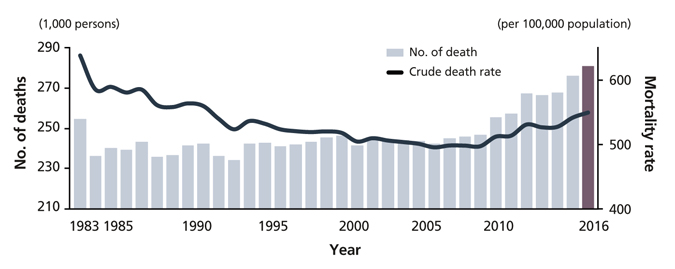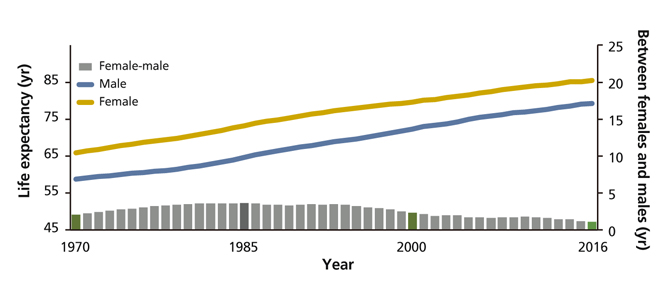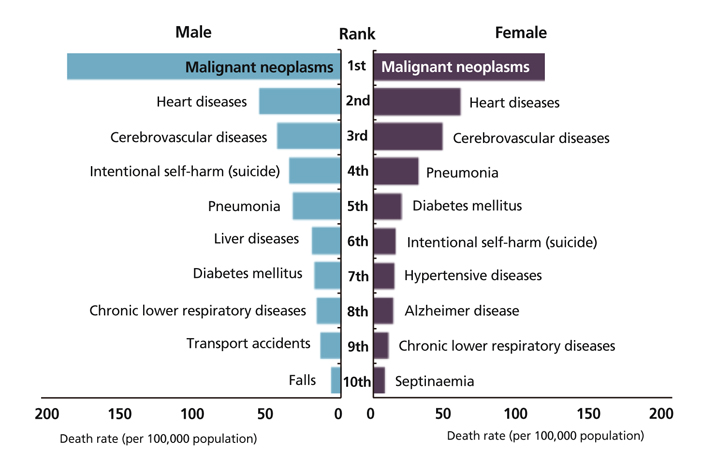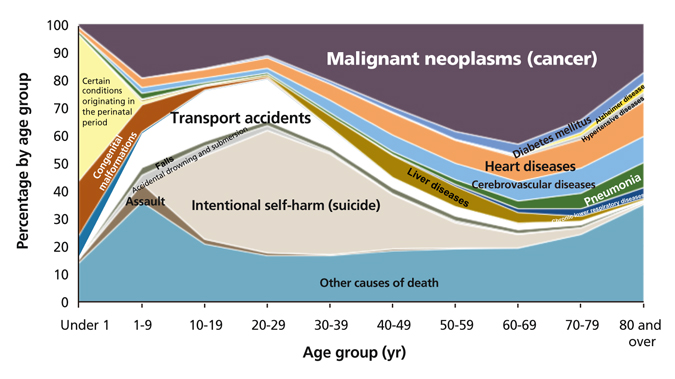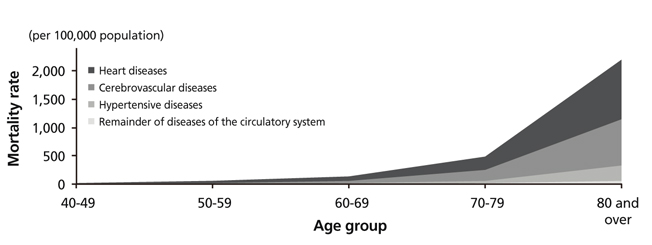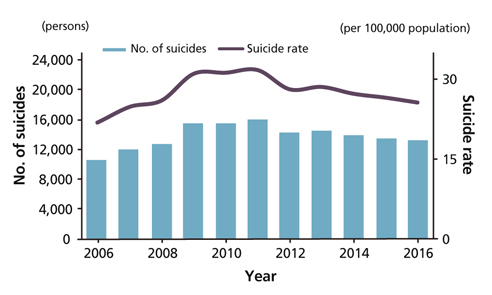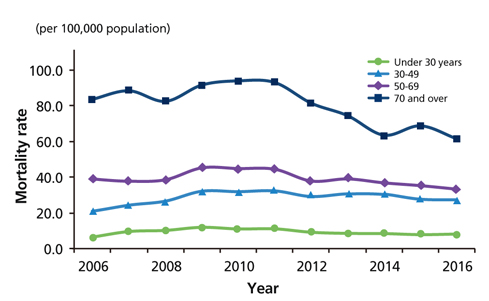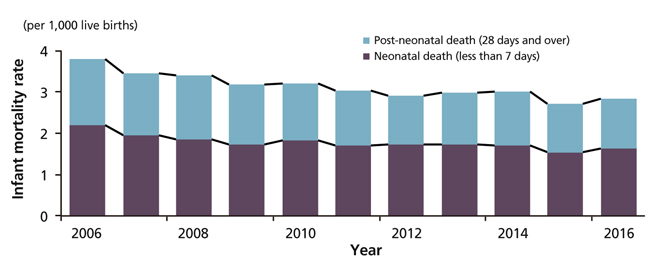Cause-of-death statistics in 2016 in the Republic of Korea
- Affiliations
-
- 1Vital Statistics Division, Statistics Korea, Daejeon, Korea.
- 2Department of Family Medicine, Myongji Hospital, Hanyang University College of Medicine, Goyang, Korea.
- 3Department of Parasitology and Institute of Medical Education, College of Medicine, Hallym University, Chuncheon, Korea. shuh@hallym.ac.kr
- KMID: 2420369
- DOI: http://doi.org/10.5124/jkma.2018.61.9.573
Abstract
- This study aimed to analyze changes in the causes of death in the Korean population in 2016 and to provide some insights regarding how to cope with related issues of public health and welfare. The causes of death made available by Statistics Korea were classified according to the International Statistical Classification of Diseases and Related Health Problems, 10th revision as well as the KCD-7 (Korean Standard Classification of Diseases and Causes of Death), which has been modified to fit circumstances in Korea. The total number of deaths was 280,827, which was an increase of 4,932 (1.8%) from 2015. The crude death rate was 549.4 per 100,000 population, which was an increase of 7.9 (1.5%) from 2015. The 10 leading causes of death, in order, were malignant neoplasms, heart diseases, cerebrovascular diseases, pneumonia, intentional self-harm, diabetes mellitus, chronic lower respiratory diseases, liver diseases, hypertensive diseases, and transport accidents. The rank of hypertensive diseases rose from 10th in 2015 to 9th in 2016, while that of transfer accidents dropped from 9th in 2015 to 10th in 2016. The proportion of the number of deaths caused by cancer was 27.8%. The death rate due to cancer was 153.0 per 100,000 population, which was an increase of 1.4% from 2015; 16.5 deaths per 100,000 population were due to colon cancer, and 16.2 were due to stomach cancer. The above trends in causes of death reflect aspects of the population structure, disease patterns, lifestyle, and medical care in present-day Korean society.
Keyword
MeSH Terms
Figure
Cited by 9 articles
-
Impact of the COVID-19 Outbreak on Trends in Emergency Department Utilization in Children: a Multicenter Retrospective Observational Study in Seoul Metropolitan Area, Korea
Dong Hyun Choi, Jae Yun Jung, Dongbum Suh, Jea Yeon Choi, Se Uk Lee, Yoo Jin Choi, Young Ho Kwak, Do Kyun Kim
J Korean Med Sci. 2021;36(5):e44. doi: 10.3346/jkms.2021.36.e44.Screening for Atrial Fibrillation Using a Smartphone-Based Electrocardiogram in Korean Elderly
Nu Ri Kim, Chang Kyun Choi, Hyeong-Suk Kim, Su-Hyun Oh, Jung-Hwa Yang, Ki Hong Lee, Ju Han Kim, Man-Seok Park, Hye-Yeon Kim, Min-Ho Shin
Chonnam Med J. 2020;56(1):50-54. doi: 10.4068/cmj.2020.56.1.50.Child injury death statistics from 2006 to 2016 in the Republic of Korea
, Hyun-Young Shin, Ji-Youn Lee, Jee-Eun Kim, Seokmin Lee, Sun Huh
J Korean Med Assoc. 2019;62(5):283-292. doi: 10.5124/jkma.2019.62.5.283.Statin Intolerance: an Overview of the Current Status and Possible Treatment Options
Sunghwan Suh, Chang Hee Jung, Soon-Jun Hong, Jung-Sun Kim, Sung Hee Choi
J Lipid Atheroscler. 2018;7(2):77-87. doi: 10.12997/jla.2018.7.2.77.Diabetes Fact Sheets in Korea, 2018: An Appraisal of Current Status
Bo-Yeon Kim, Jong Chul Won, Jae Hyuk Lee, Hun-Sung Kim, Jung Hwan Park, Kyoung Hwa Ha, Kyu Chang Won, Dae Jung Kim, Kyong Soo Park
Diabetes Metab J. 2019;43(4):487-494. doi: 10.4093/dmj.2019.0067.Long-term impact of coronavirus disease 2019 pandemic on emergency department utilization in a metropolitan emergency department in Korea
Seung Yeon Hwang, Jae Kwang Lee, Hyun Sik Ryu, Seong Soo Park, Jun Young Choi, Hye Ji Lee, Seung Ho Hur, Yeong Geun Park, Hyun Soo Choi
Pediatr Emerg Med J. 2021;8(2):57-65. doi: 10.22470/pemj.2021.00346.Comparison of Fentanyl versus Meperidine in Combination with Midazolam for Sedative Colonoscopy in Korea
Gwan Woo Hong, Jun Kyu Lee, Jung Hyeon Lee, Ji Hun Bong, Sung Hun Choi, Hyeki Cho, Ji Hyung Nam, Dong Kee Jang, Hyoun Woo Kang, Jae Hak Kim, Yun Jeong Lim, Moon Soo Koh, Jin Ho Lee
Clin Endosc. 2020;53(5):562-567. doi: 10.5946/ce.2020.022.Cause of Mortality after Radical Prostatectomy and the Impact of Comorbidity in Men with Prostate Cancer: A Multi-institutional Study in Korea
Sahyun Pak, Dalsan You, In Gab Jeong, Dong-Eun Lee, Sung Han Kim, Jae Young Joung, Kang-Hyun Lee, Jun Hyuk Hong, Choung-Soo Kim, Hanjong Ahn
Cancer Res Treat. 2020;52(4):1242-1250. doi: 10.4143/crt.2020.286.Successful Aging Transition and Its Impact on Self-Rated Health and Life Satisfaction: Findings from the Korean Longitudinal Study of Aging (2006-2018)
Yoo Bin Seo, Yun Jun Yang
Korean J Health Promot. 2022;22(2):103-112. doi: 10.15384/kjhp.2022.22.2.103.
Reference
-
1. Shin HY, Lee JY, Song J, Lee S, Lee J, Lim B, Kim H, Huh S. Cause-of-death statistics in the Republic of Korea, 2014. J Korean Med Assoc. 2016; 59:221–232.
Article2. Statistics Korea. Birth statistics in 2016 [Internet]. Daejeon: Statistics Korea;2017. cited 2018 Aug 15. Available from: http://www.index.go.kr/potal/main/EachDtlPageDetail.do?idx_cd=1428.3. Statistics Korea. Annual report on the causes of death statistics [Internet]. Daejeon: Statistics Korea;2017. cited 2018 Aug 15. Available from: http://kostat.go.kr/portal/korea/kor_nw/2/6/2/index.board.4. World Health Organization. International Statistical Classification of Diseases and Related Health Problems 10th revision 2016 [Internet]. Geneva: World Health Organization;2016. cited 2018 Aug 15. Available from: http://apps.who.int/classifications/icd10/browse/2016/en.5. Statistics Korea. Korean Standard Classification of Diseases and Causes of Death (KCD-6) [Internet]. Daejeon: Statistics Korea;2011. cited 2018 Aug 15. Available from: https://kssc.kostat.go.kr:8443/ksscNew_web/ekssc/main/main.do.6. Lee SI, Moon HY, Kwak JM, Kim J, Min BW, Um JW, Kim SH. Relationship between meat and cereal consumption and colorectal cancer in Korea and Japan. J Gastroenterol Hepatol. 2008; 23:138–140.
Article7. Yoon M, Kim N, Nam B, Joo J, Ki M. Changing trends in colorectal cancer in the Republic of Korea: contrast with Japan. Epidemiol Health. 2015; 37:e2015038.
Article8. Yang K, Choi YY, Zhang WH, Chen XZ, Song MK, Lee J, Zhang B, Chen ZX, Kim HI, Chen JP, Cheong JH, Zhou ZG, Hyung WJ, Hu JK, Noh SH. Strategies to improve treatment outcome in gastric cancer: a retrospective analysis of patients from two high-volume hospitals in Korea and China. Oncotarget. 2016; 7:44660–44675.
Article9. Choi E, Lee S, Nhung BC, Suh M, Park B, Jun JK, Choi KS. Cancer mortality-to-incidence ratio as an indicator of cancer management outcomes in Organization for Economic Cooperation and Development countries. Epidemiol Health. 2017; 39:e2017006.
Article10. Ministry of Health and Welfare. National Action Plan for Prevention of Intentional Self-harm in January 2018 [Internet]. Sejong: Ministry of Health and Welfare;2018. cited 2018 Aug 15. Available from: https://www.gov.kr/portal/ntnadmNews/1324029.11. World Health Organization. Global status report on alcohol and health 2014 [Internet]. Geneva: World Health Organization;2014. cited 2018 Aug 15. Available from: http://www.who.int/substance_abuse/publications/global_alcohol_report/en/.12. Jung KW, Won YJ, Kong HJ, Lee ES. Community of Population-Based Regional Cancer Registries. Cancer statistics in Korea: incidence, mortality, survival, and prevalence in 2015. Cancer Res Treat. 2018; 50:303–316.
Article

